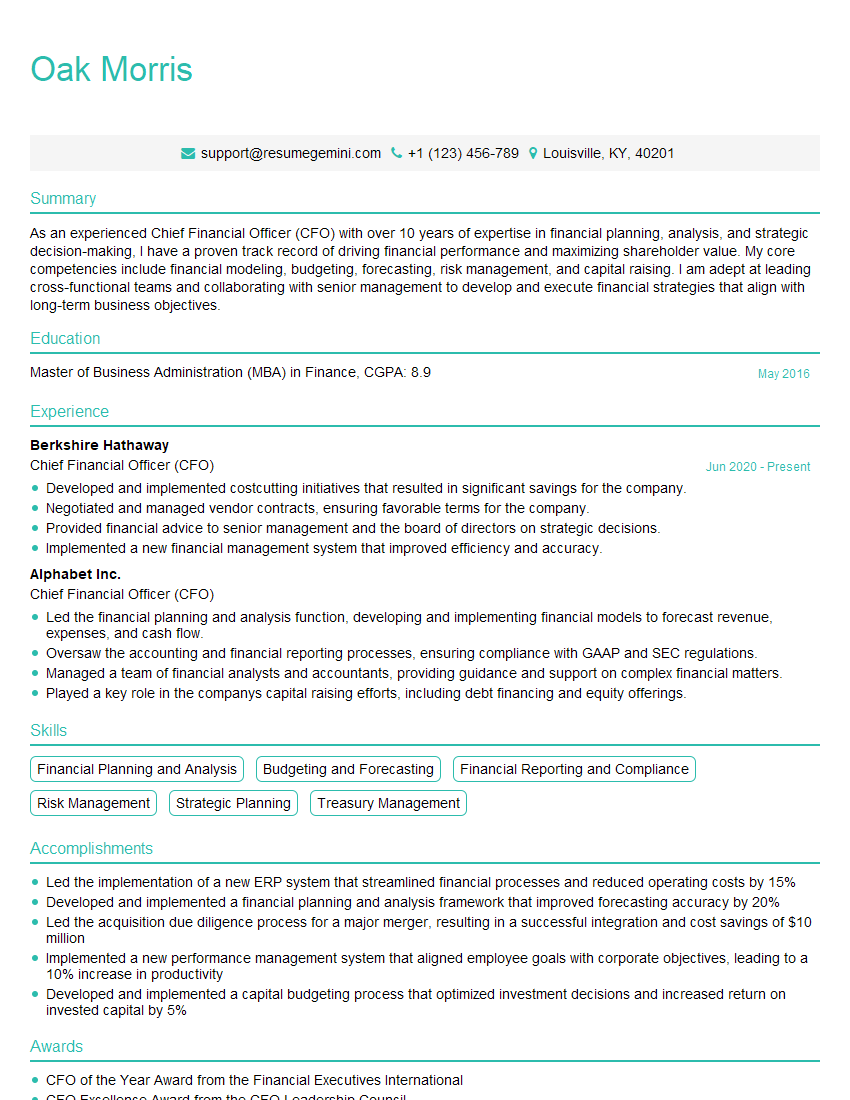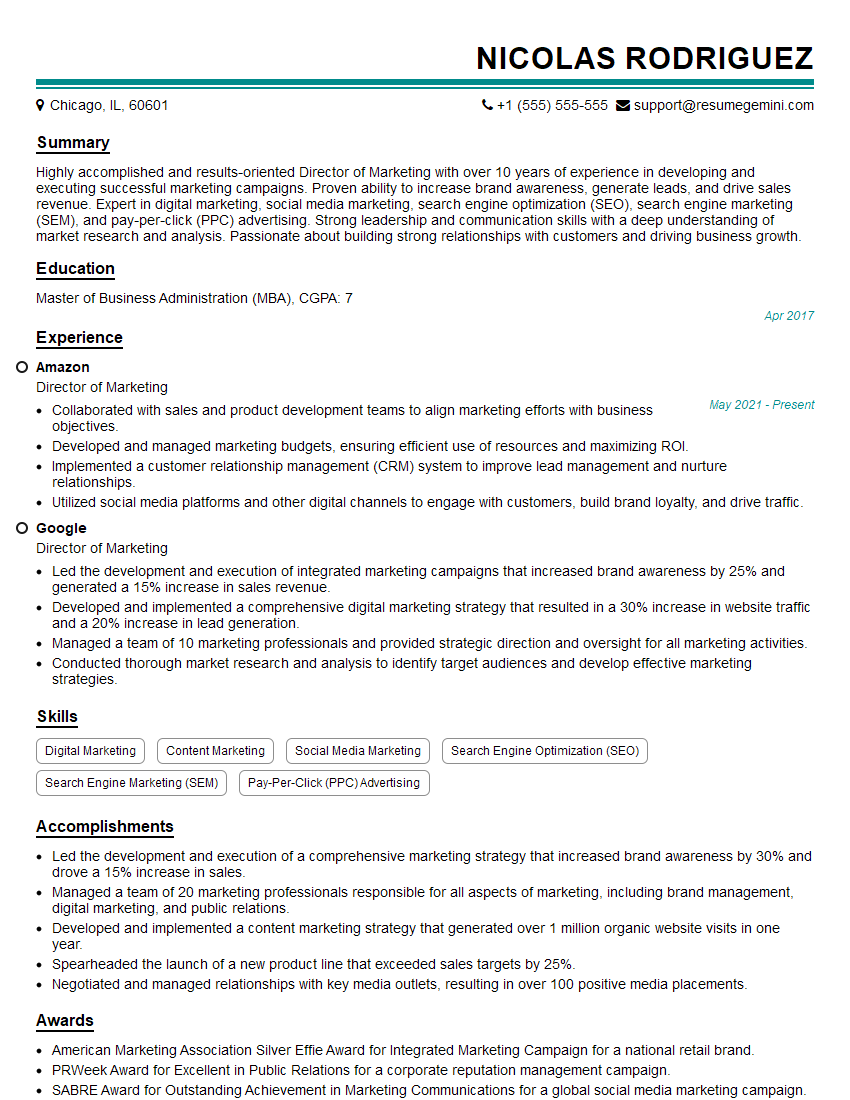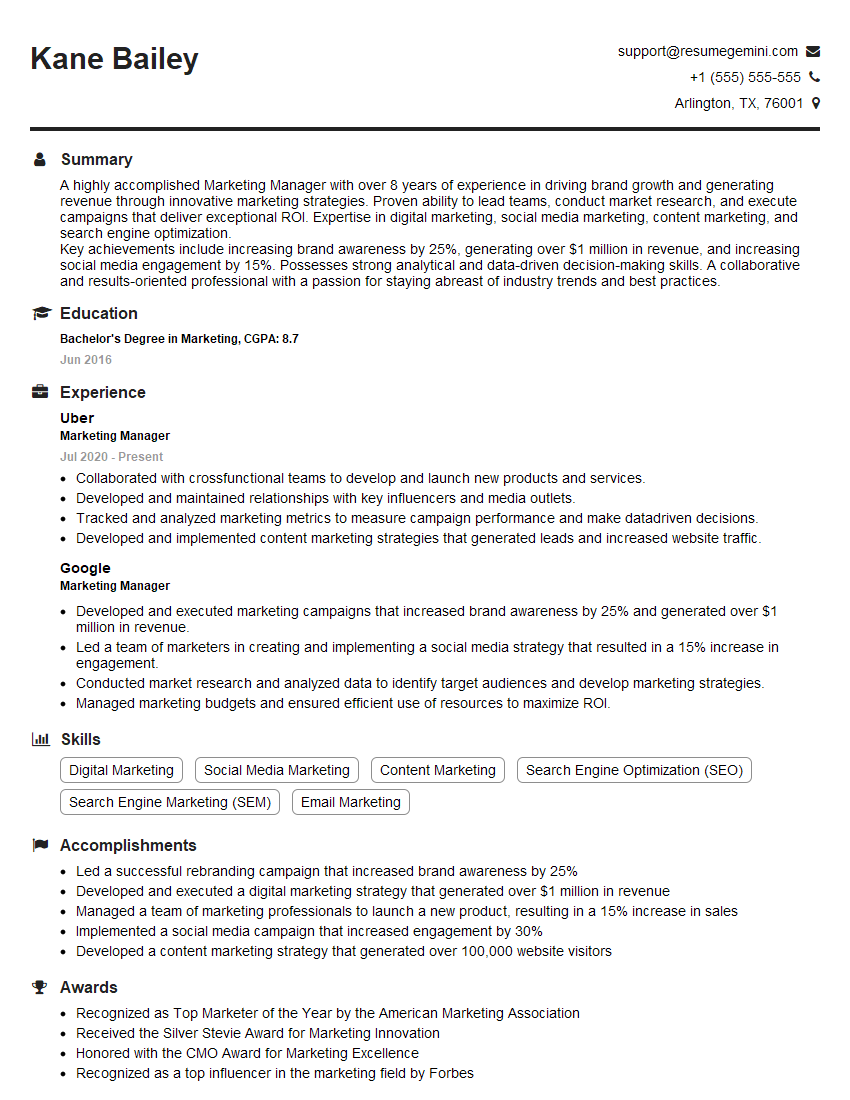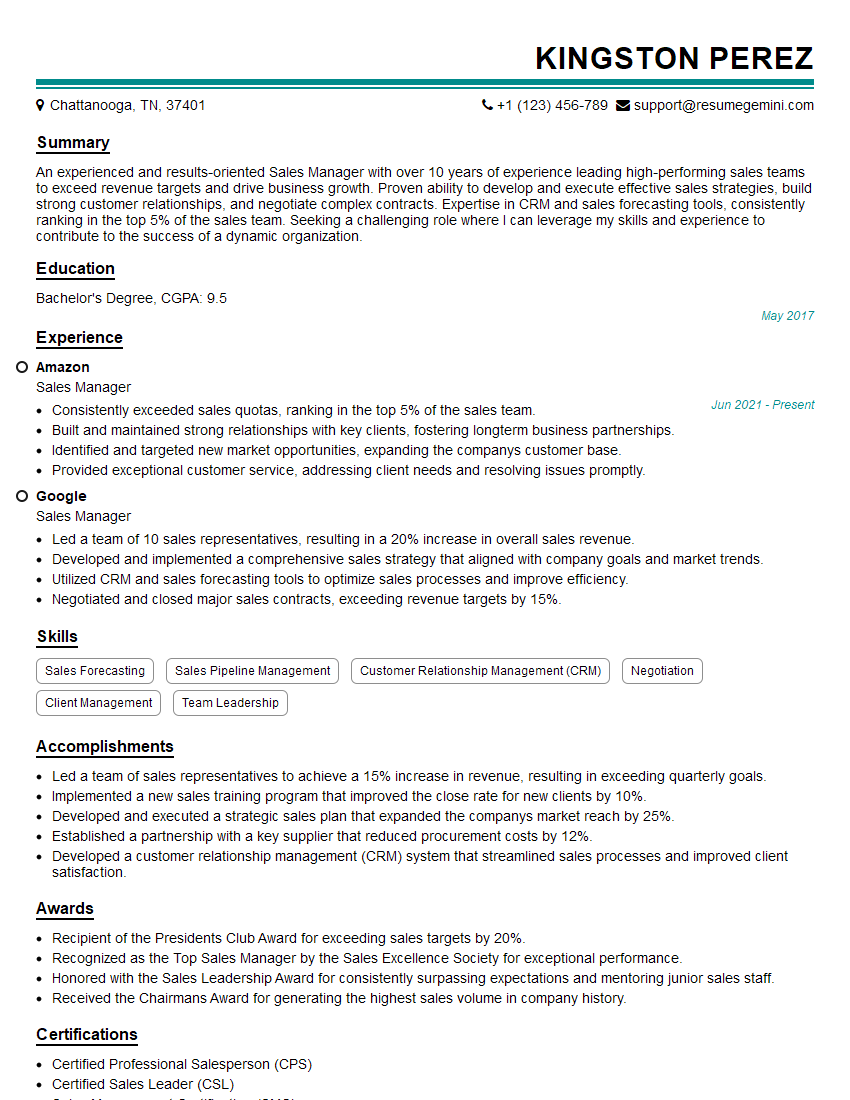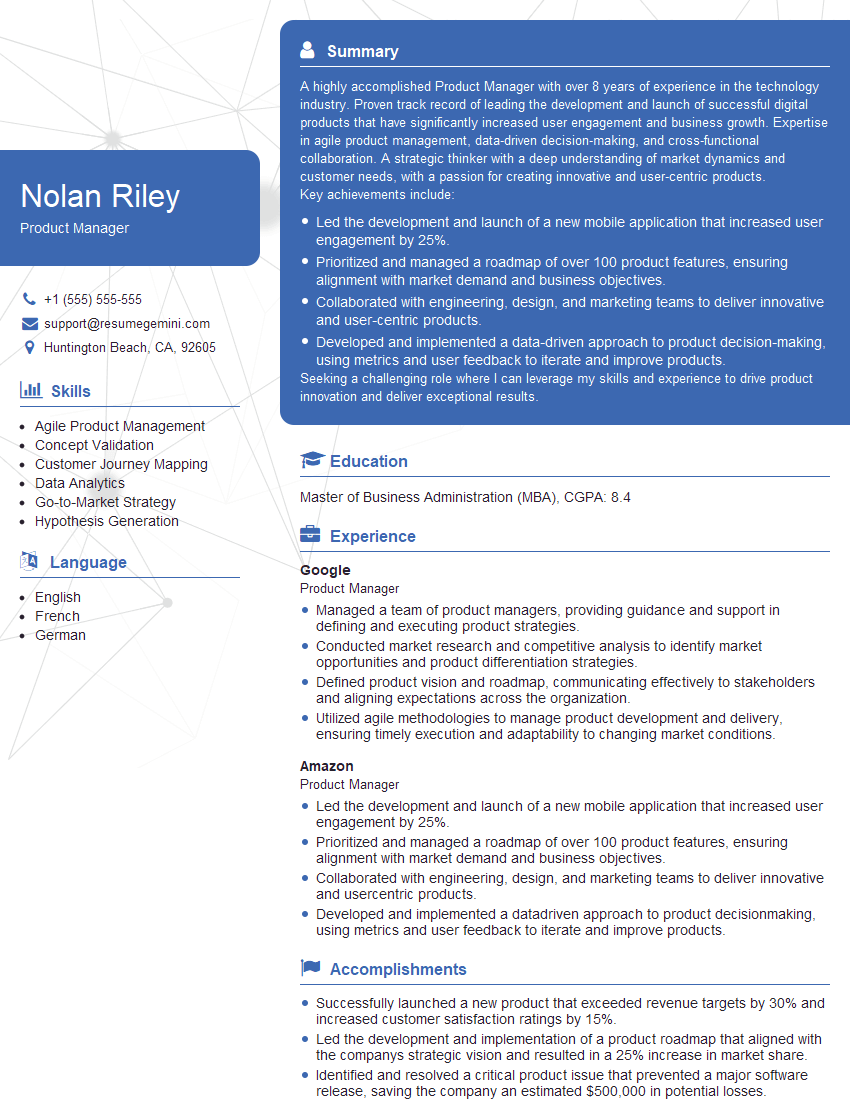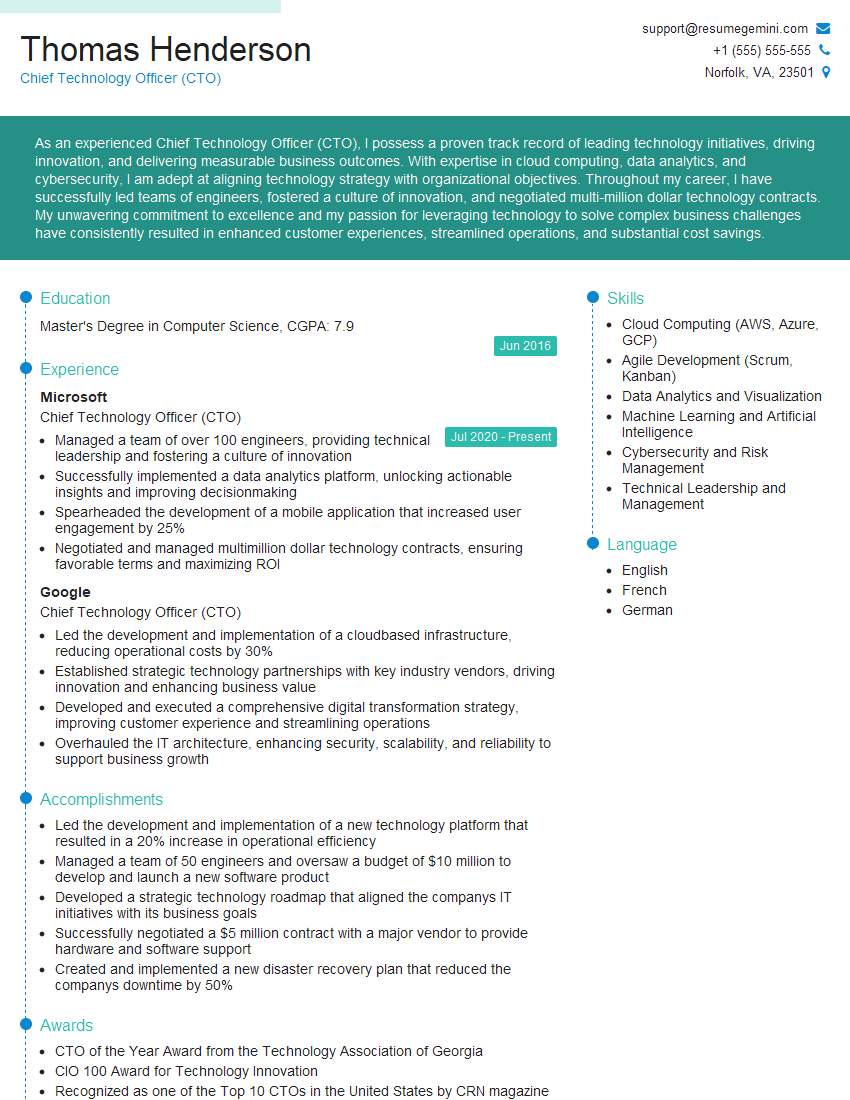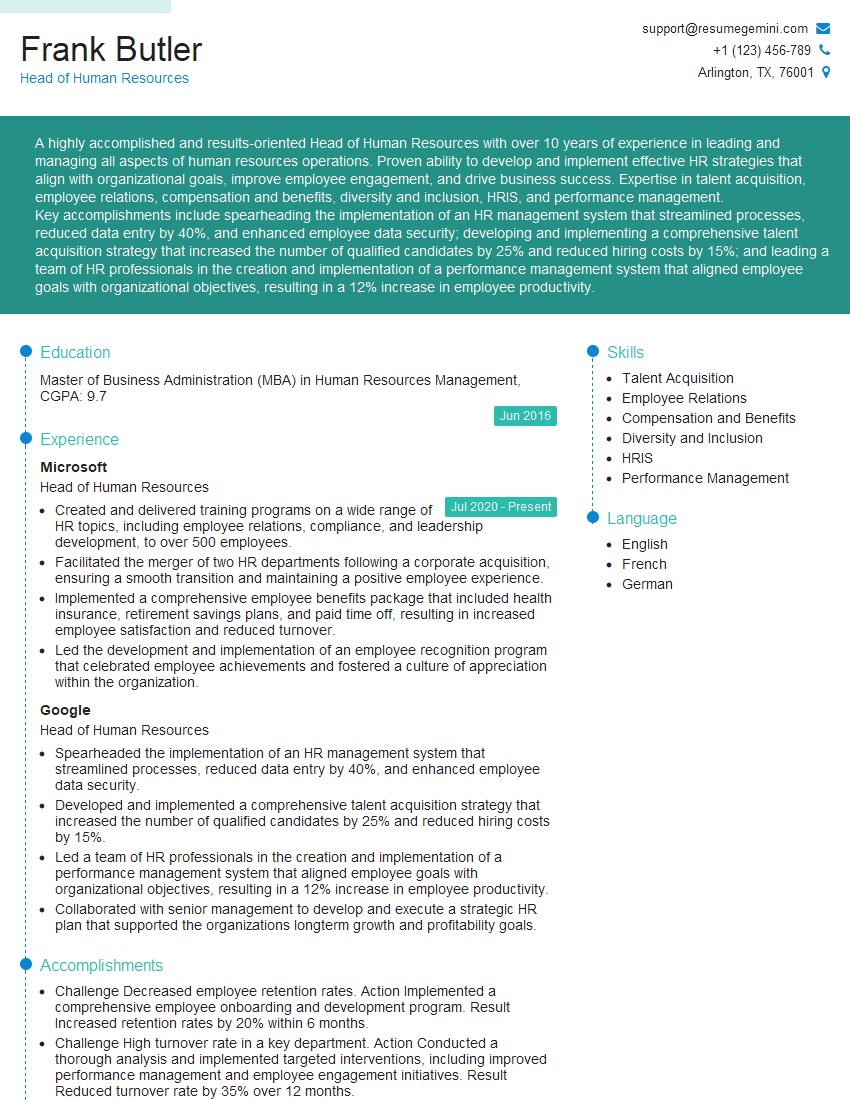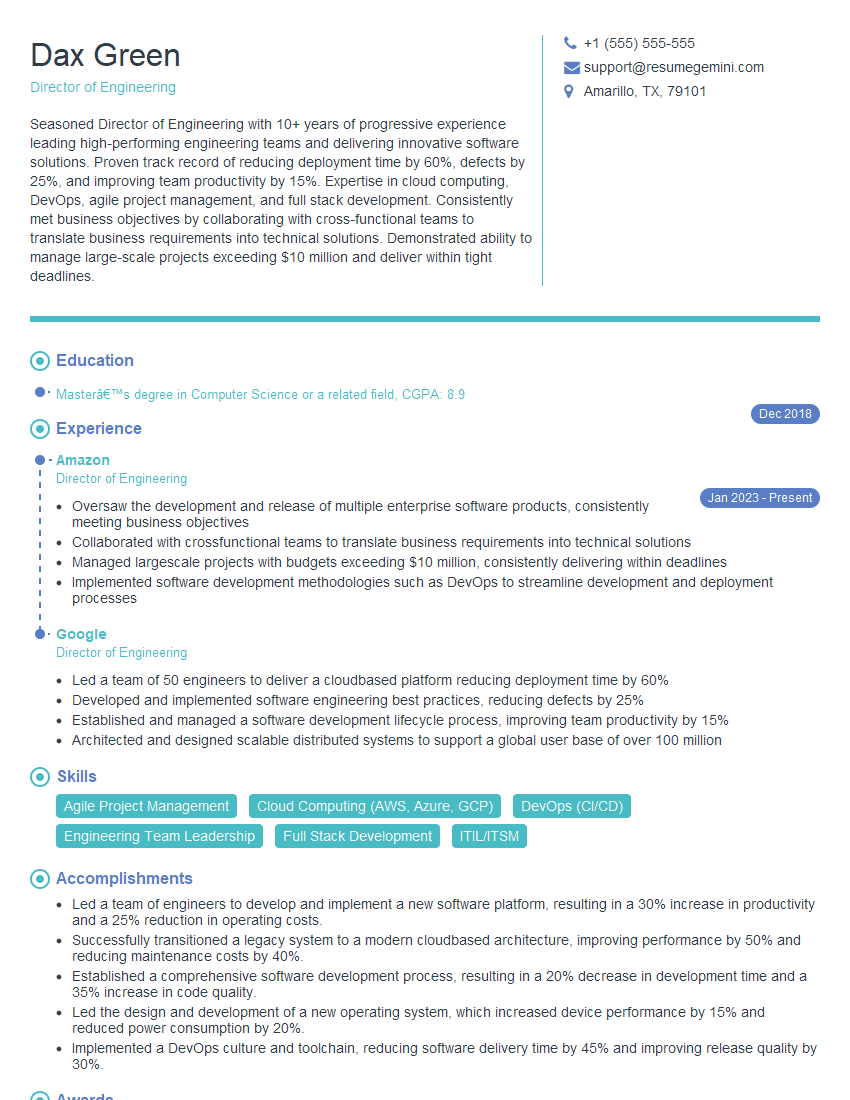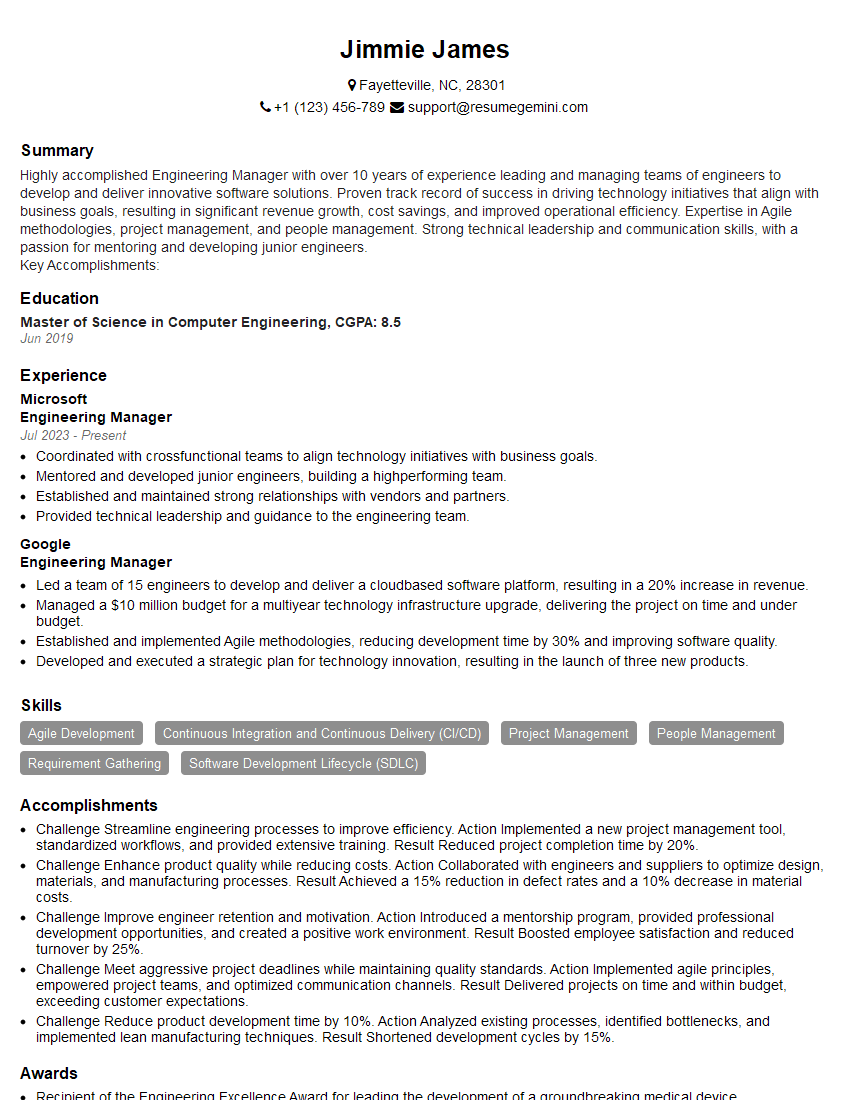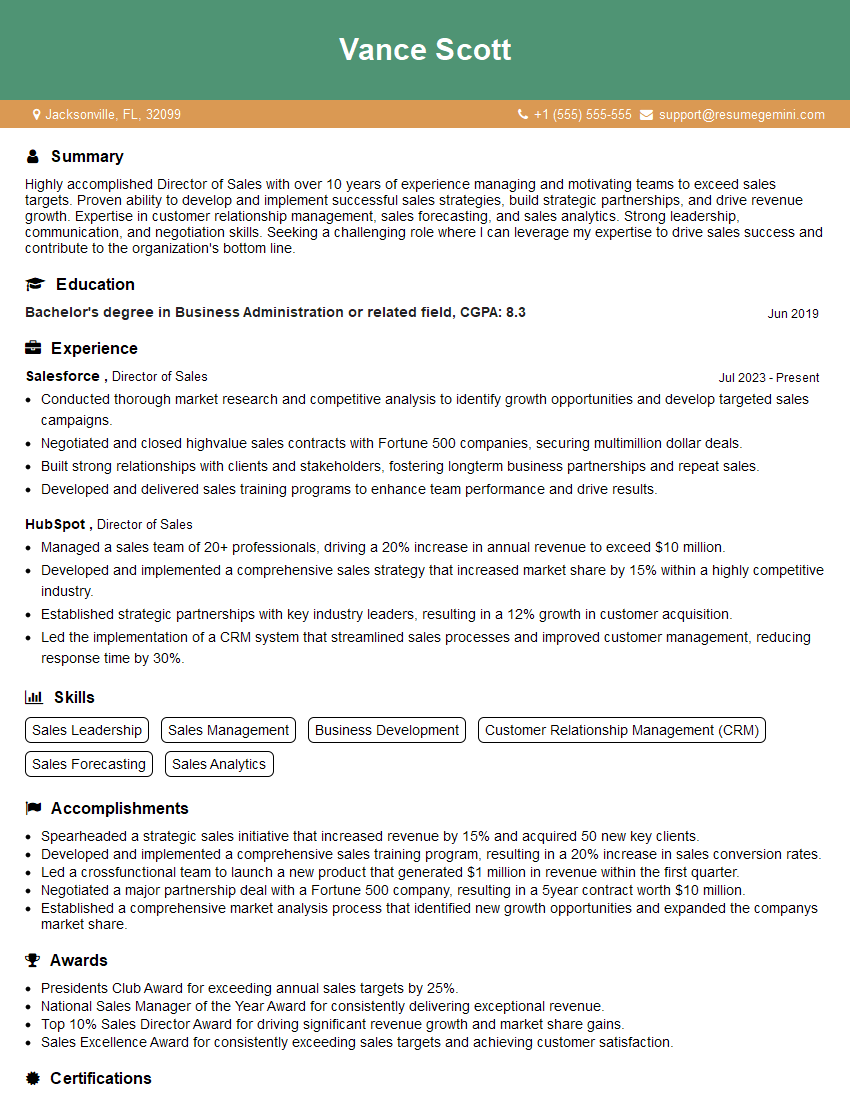Feeling uncertain about what to expect in your upcoming interview? We’ve got you covered! This blog highlights the most important Start-up Management interview questions and provides actionable advice to help you stand out as the ideal candidate. Let’s pave the way for your success.
Questions Asked in Start-up Management Interview
Q 1. Describe your experience with lean startup methodologies.
Lean startup methodologies are all about building and iterating quickly, focusing on validated learning and minimizing wasted resources. It’s about building the right product, not just a product quickly. Instead of extensive upfront planning, a lean startup emphasizes building a Minimum Viable Product (MVP) first, then iteratively improving it based on customer feedback. Think of it as a scientific experiment where each iteration tests a hypothesis about what customers want.
In my previous role at ‘InnovateTech,’ we used the Lean Canvas framework to define our business model. This helped us to quickly identify our key partners, customer segments, and value propositions. We then built a basic MVP and launched it to a limited audience. Through continuous testing and user feedback, we identified several key features that resonated strongly with customers, while others were scrapped. This iterative approach allowed us to significantly reduce development time and costs while ensuring we were building a product that actually met market demands.
- Build-Measure-Learn feedback loop: This iterative process is at the heart of the Lean Startup. We continuously build features, measure their impact, and learn from the results to inform future development.
- Customer Development: This involves talking to potential customers early and often to validate our assumptions and gather feedback.
- A/B testing: We used A/B testing extensively to compare different versions of features and landing pages to see which performed better.
Q 2. Explain your understanding of the Agile development process in a startup context.
Agile development, in the context of a startup, is a project management approach that prioritizes flexibility, collaboration, and rapid iteration. It’s perfectly suited to the dynamic and uncertain environment of a startup where requirements can change frequently. Instead of a rigid, sequential plan, Agile uses short development cycles (sprints) typically lasting 1-4 weeks. Each sprint delivers a working increment of the software, allowing for early and continuous feedback.
During my time at ‘GreenThumb Solutions,’ a gardening app startup, we employed Scrum, a popular Agile framework. We had daily stand-up meetings to track progress, identify roadblocks, and ensure everyone was aligned. At the end of each sprint, we had a sprint review where we demonstrated the working software to stakeholders and gathered feedback. This iterative approach enabled us to incorporate feedback quickly, adapt to changing market needs, and deliver a higher-quality product that met the evolving demands of our user base.
- Iterative Development: The product is developed in small increments, allowing for frequent testing and feedback.
- Frequent Feedback Loops: Regular reviews and demonstrations ensure that the product aligns with user needs and market trends.
- Cross-functional Teams: Collaboration between developers, designers, and product managers is key to ensure efficiency and quality.
Q 3. How would you define and measure key performance indicators (KPIs) for a startup?
Defining and measuring KPIs for a startup depends heavily on the stage of the business and its goals. Early-stage startups might focus on validation metrics, while later-stage startups might prioritize growth and profitability. KPIs should always be SMART – Specific, Measurable, Achievable, Relevant, and Time-bound.
For example, an early-stage SaaS startup might focus on KPIs like:
- Website Traffic: Measuring the number of visitors to the website and their engagement (time on site, bounce rate).
- Conversion Rate: The percentage of website visitors who sign up for a free trial or purchase the product.
- Customer Acquisition Cost (CAC): The cost of acquiring a new customer.
- Monthly Recurring Revenue (MRR): The predictable revenue generated each month from subscriptions.
A more mature startup might also include:
- Customer Churn Rate: The percentage of customers who cancel their subscriptions.
- Customer Lifetime Value (CLTV): The total revenue generated by a customer over their relationship with the company.
- Net Promoter Score (NPS): A measure of customer satisfaction and loyalty.
- Average Revenue Per User (ARPU): The average revenue generated per user.
It’s crucial to monitor these KPIs regularly and adjust strategies based on performance.
Q 4. Describe your experience with market research and competitive analysis for a new product launch.
Market research and competitive analysis are crucial for a successful product launch. It’s about understanding the landscape, identifying your target audience, and differentiating your offering. This involves both qualitative and quantitative research methods.
When launching a new fitness app, I conducted thorough market research which included:
- Competitive Analysis: I analyzed existing fitness apps, identifying their strengths, weaknesses, pricing models, and target audiences. This helped us understand the competitive landscape and identify opportunities for differentiation.
- Surveys and Interviews: I conducted surveys and interviews with potential users to understand their needs, preferences, and pain points. This qualitative data helped us refine our product features and messaging.
- Secondary Research: I leveraged existing market reports and industry publications to get a better understanding of market trends and size.
- SWOT Analysis: I created a SWOT analysis to identify the company’s internal strengths and weaknesses, as well as external opportunities and threats.
This comprehensive research process enabled us to develop a strong value proposition, target the right audience, and position our app effectively within the competitive market.
Q 5. How would you approach building a minimal viable product (MVP)?
Building an MVP (Minimum Viable Product) is about creating a version of your product with just enough features to attract early-adopter customers and validate your core assumptions. It’s not about building a perfect product; it’s about learning fast and iterating quickly. The goal is to gather feedback and learn what works before investing heavily in features that may not be valuable to customers.
My approach involves:
- Identify Core Features: Focus on the essential features that deliver the core value proposition.
- Prioritize Features: Use a prioritization matrix (like MoSCoW – Must have, Should have, Could have, Won’t have) to decide which features to include in the MVP.
- Rapid Prototyping: Use tools like Figma or InVision to create quick prototypes to test the user interface and user experience (UI/UX).
- Iterative Development: Develop the MVP in short iterations, incorporating user feedback at each stage.
- Launch and Test: Release the MVP to a limited audience to gather real-world feedback.
For instance, when creating a food delivery app, the MVP might only include the core features: user registration, restaurant listing, order placement, and basic tracking. Later iterations would add features such as payment integration, multiple delivery options, and customer reviews.
Q 6. What strategies would you employ for user acquisition and retention in a startup?
User acquisition and retention are critical for startup success. It’s a two-pronged approach focusing on attracting new users and keeping existing ones engaged. Strategies will differ based on your target audience and the nature of your product.
User Acquisition strategies could include:
- Content Marketing: Creating valuable content (blog posts, articles, videos) to attract your target audience.
- Social Media Marketing: Using social media platforms to build brand awareness and engage with potential customers.
- Search Engine Optimization (SEO): Optimizing your website to rank higher in search engine results.
- Paid Advertising: Using platforms like Google Ads or social media ads to reach a wider audience.
- Partnerships: Collaborating with complementary businesses to reach new customers.
User Retention strategies could include:
- Personalized Communication: Sending targeted emails and in-app messages to engage users.
- Loyalty Programs: Offering rewards and incentives to encourage repeat usage.
- Community Building: Creating a forum or community to foster engagement and interaction among users.
- Exceptional Customer Service: Providing prompt and helpful support to address user issues.
- Regular Updates and Improvements: Continuously updating the product with new features and improvements.
Q 7. Explain your approach to managing a limited budget and resources in a startup environment.
Managing a limited budget and resources in a startup requires careful planning and prioritization. It’s about making every dollar count and being resourceful. The key is to focus on the most impactful activities and avoid unnecessary expenses.
My approach includes:
- Prioritize Essential Expenses: Focus on core functions and cut unnecessary expenses.
- Bootstrap as Much as Possible: Leverage free or low-cost tools and resources whenever possible.
- Outsource Strategically: Outsource non-core functions to free up internal resources.
- Track Expenses Closely: Monitor spending carefully and identify areas for improvement.
- Seek Funding Wisely: Explore different funding options, including grants, angel investors, or venture capital.
- Negotiate Favorable Terms: Negotiate with vendors and suppliers to secure better pricing.
- Embrace Lean Principles: Implement lean principles to optimize processes and eliminate waste.
For example, instead of hiring a full-time marketing team, we might initially rely on freelance marketers or utilize cost-effective marketing channels. Similarly, we might use free project management tools or leverage open-source software to reduce expenses.
Q 8. How would you handle conflict resolution within a fast-paced startup team?
Conflict is inevitable in a fast-paced startup; the key is proactive management. My approach focuses on early identification, open communication, and collaborative solutions. I believe in establishing a culture of respectful disagreement where differing opinions are valued, not feared.
- Early Intervention: I actively encourage team members to voice concerns before they escalate. Regular check-ins and informal team meetings provide opportunities for open dialogue.
- Active Listening & Empathy: When conflict arises, I facilitate a structured discussion where all parties feel heard and understood. This involves actively listening to each perspective without judgment, and seeking to understand the underlying emotions and needs.
- Collaborative Problem Solving: Instead of imposing solutions, I guide the team towards a mutually acceptable outcome. This involves brainstorming solutions together, considering the impact on all stakeholders, and agreeing on a clear action plan.
- Mediation if Necessary: For more complex or intractable conflicts, I might facilitate a formal mediation process, involving a neutral third party if needed. The goal is always to preserve the working relationship and find a resolution that strengthens the team.
For example, in a previous startup, a disagreement arose between the engineering and marketing teams regarding product feature prioritization. Instead of taking sides, I organized a workshop where both teams presented their perspectives, identified the root causes of the conflict (different metrics and priorities), and collaboratively developed a prioritized roadmap that incorporated elements from both sides.
Q 9. Describe your experience with fundraising or securing investment for a startup.
My experience with fundraising spans several successful rounds, from seed funding to Series A. I approach fundraising strategically, focusing on building strong relationships with investors and crafting compelling narratives.
- Market Research & Investor Targeting: Before reaching out to investors, I thoroughly research the market and identify investors whose investment thesis aligns with our startup’s vision and stage. This targeted approach increases the chances of securing funding.
- Compelling Pitch Deck: I develop a concise and compelling pitch deck that highlights our value proposition, market opportunity, team expertise, and financial projections. This is a crucial tool for communicating our vision effectively to potential investors.
- Building Relationships: I prioritize building strong relationships with potential investors through networking events, industry conferences, and targeted outreach. Trust and rapport are vital for securing investment.
- Negotiation & Due Diligence: I’m adept at negotiating terms and navigating the due diligence process. This requires a thorough understanding of legal and financial aspects of fundraising.
In one instance, we secured Series A funding by demonstrating a strong product-market fit, a clear path to profitability, and a seasoned management team. Our detailed financial projections, combined with a compelling narrative showcasing our impact on the market, resonated strongly with investors.
Q 10. How would you prioritize tasks and projects in a high-pressure startup setting?
Prioritization in a startup is crucial for efficient resource allocation and achieving key objectives. I utilize a combination of frameworks and methodologies to ensure focus on high-impact tasks.
- Eisenhower Matrix (Urgent/Important): This helps categorize tasks based on urgency and importance. Focusing on important but not urgent tasks prevents crises and builds a stronger foundation.
- MoSCoW Method (Must have, Should have, Could have, Won’t have): This framework helps prioritize features and functionalities during product development, focusing resources on essential elements.
- Data-Driven Decisions: I rely on data analytics to inform prioritization. This includes tracking key metrics, analyzing user behavior, and using A/B testing to validate decisions.
- Agile Methodologies: Adopting Agile principles, such as sprints and daily stand-ups, enables iterative development and flexibility in adapting to changing priorities.
For instance, during a product launch, using the MoSCoW method allowed us to focus development resources on the ‘must-have’ features first, ensuring a successful minimum viable product (MVP) launch. We then iteratively added ‘should have’ and ‘could have’ features based on user feedback and data analysis.
Q 11. Explain your experience with A/B testing and data-driven decision-making.
A/B testing and data-driven decision-making are cornerstones of my approach to optimizing product development and marketing strategies. I have extensive experience designing and analyzing A/B tests to validate hypotheses and improve user experiences.
- Hypothesis Formulation: A/B testing starts with clearly defined hypotheses about how changes might impact key metrics (e.g., conversion rates, click-through rates).
- Test Design & Implementation: I design rigorous A/B tests, carefully controlling variables and ensuring sufficient sample sizes to yield statistically significant results. This often involves using analytics platforms like Google Analytics or Optimizely.
- Data Analysis & Interpretation: I analyze the results of A/B tests using statistical methods to identify significant differences between variations. This involves understanding p-values and confidence intervals to avoid drawing misleading conclusions.
- Iterative Improvement: Based on the results of A/B tests, I make data-driven decisions to optimize products, marketing campaigns, or user interfaces. The process is iterative, with continuous testing and improvement.
For example, in a previous role, we conducted an A/B test on our landing page, comparing two different call-to-action buttons. The data revealed a 15% increase in conversion rates with the revised button, leading to a significant improvement in lead generation.
Q 12. What is your experience with scaling a startup’s operations?
Scaling a startup involves strategically expanding operations to meet increasing demand while maintaining efficiency and quality. This requires careful planning and execution across various aspects of the business.
- Infrastructure Scaling: This includes upgrading technology infrastructure (servers, databases), optimizing processes, and automating repetitive tasks. Cloud computing solutions play a vital role here.
- Team Expansion: Strategic hiring and onboarding are critical to scaling effectively. This involves defining clear roles, establishing effective communication channels, and fostering a collaborative work environment.
- Process Optimization: Streamlining workflows and standardizing processes improve efficiency as the team grows. This might involve implementing project management tools or refining internal communication protocols.
- Financial Management: Scaling requires careful financial planning and resource allocation. This involves projecting revenue, managing expenses, and securing additional funding as needed.
In one project, we successfully scaled operations by implementing a new customer relationship management (CRM) system, automating key processes, and hiring specialized personnel to handle increased customer support requests. This enabled us to maintain high service levels while expanding our customer base significantly.
Q 13. How would you build and manage a high-performing startup team?
Building a high-performing startup team involves attracting, retaining, and motivating talented individuals who share a common vision. My approach is centered around fostering a positive and productive work environment.
- Clear Vision & Values: Establishing a clear vision and core values helps attract and retain employees who align with the company culture.
- Strategic Hiring: Recruiting individuals with the right skills, experience, and cultural fit is crucial. This involves thorough screening, interviewing, and reference checks.
- Empowerment & Ownership: Empowering team members to take ownership of their work fosters motivation and engagement. This involves providing autonomy, acknowledging contributions, and offering opportunities for growth.
- Open Communication & Feedback: Creating a culture of open communication, regular feedback, and constructive criticism is vital for continuous improvement and team cohesion.
- Continuous Learning & Development: Investing in employee training and development helps team members enhance their skills and stay up-to-date with industry trends.
For example, in a previous startup, we implemented a mentorship program that paired experienced team members with newer hires, facilitating knowledge transfer and fostering a supportive work environment. This enhanced team cohesion and accelerated the learning curve for new employees.
Q 14. Describe your experience with building and maintaining customer relationships.
Building and maintaining strong customer relationships is paramount for long-term success. My approach involves creating a customer-centric culture and utilizing various tools and techniques to foster loyalty.
- Customer Understanding: Understanding customer needs, preferences, and pain points is fundamental. This involves conducting market research, analyzing customer feedback, and actively listening to customer concerns.
- Proactive Communication: Regular communication with customers, through newsletters, email updates, or social media, keeps them informed and engaged.
- Personalized Service: Providing personalized support and attention shows customers that they are valued. This could involve customized email campaigns or personalized product recommendations.
- Feedback Collection & Action: Actively seeking and responding to customer feedback demonstrates a commitment to continuous improvement. This helps identify areas for improvement and enhance customer satisfaction.
- Loyalty Programs & Incentives: Implementing loyalty programs or offering incentives can encourage repeat business and foster customer loyalty.
In a previous venture, we implemented a customer feedback system that allowed customers to easily provide suggestions and report issues. We actively monitored feedback, addressed concerns promptly, and incorporated customer suggestions into product development, leading to increased customer satisfaction and retention.
Q 15. How would you handle a crisis situation within a startup?
Handling a crisis in a startup requires a swift, decisive, and transparent approach. It’s less about having a pre-defined playbook and more about adapting to the specific circumstances while maintaining calm and control. My approach involves these key steps:
- Rapid Assessment: The first priority is to quickly understand the nature and scope of the crisis. This involves gathering information from all relevant sources, including employees, customers, and any affected stakeholders. For example, if it’s a product malfunction, we’d immediately isolate the problem, assess its impact, and determine the number of affected users.
- Damage Control: Simultaneously, we initiate damage control. This could involve issuing a public statement, addressing customer concerns, or temporarily suspending affected services. Transparency and open communication are critical here – even if we don’t have all the answers yet, acknowledging the issue and outlining the steps being taken builds trust.
- Problem Solving: Once the initial chaos is managed, we assemble a dedicated team to focus on resolving the root cause of the crisis. This requires a collaborative, problem-solving approach, leveraging the expertise of different team members. Brainstorming sessions, data analysis, and potentially involving external consultants might be necessary.
- Post-Mortem Analysis: After the crisis is resolved, we conduct a thorough post-mortem analysis to identify the contributing factors and prevent similar situations in the future. This includes documenting the events, identifying weaknesses in processes or systems, and implementing corrective actions. This step is crucial for learning and improvement.
For instance, in a previous startup, we faced a server outage that impacted our core service. We followed these steps, resulting in minimal long-term damage and improved system redundancy.
Career Expert Tips:
- Ace those interviews! Prepare effectively by reviewing the Top 50 Most Common Interview Questions on ResumeGemini.
- Navigate your job search with confidence! Explore a wide range of Career Tips on ResumeGemini. Learn about common challenges and recommendations to overcome them.
- Craft the perfect resume! Master the Art of Resume Writing with ResumeGemini’s guide. Showcase your unique qualifications and achievements effectively.
- Don’t miss out on holiday savings! Build your dream resume with ResumeGemini’s ATS optimized templates.
Q 16. Explain your understanding of various startup funding models (e.g., bootstrapping, angel investors, VC).
Startup funding models vary widely, each with its own advantages and drawbacks. Let’s explore some of the most common:
- Bootstrapping: This involves funding the startup solely through personal savings, revenue, and minimal external investment. It offers complete control but can severely limit growth potential. Think of a local bakery initially funded only by the owner’s savings.
- Angel Investors: These are high-net-worth individuals who invest their own money in early-stage startups in exchange for equity. They often provide not only capital but also valuable mentorship and industry connections. An example is an experienced entrepreneur investing in a promising tech startup.
- Venture Capital (VC): Venture capitalists are firms that invest in startups with high-growth potential. They typically invest larger sums of money than angel investors and usually expect a significant return on investment. VCs frequently invest in technology companies with disruptive ideas.
- Crowdfunding: This involves raising funds from a large number of individuals through online platforms. It’s often used for pre-orders or to build initial community support. Kickstarter and Indiegogo are prime examples.
- Incubators and Accelerators: These organizations provide startups with resources such as mentorship, workspace, and funding in exchange for equity. They offer a structured program aimed at accelerating growth.
The choice of funding model depends on factors such as the startup’s stage, industry, risk tolerance, and founder’s network.
Q 17. What are some common pitfalls to avoid when managing a startup?
Many pitfalls can derail a promising startup. Here are some of the most common to avoid:
- Ignoring Customer Feedback: Building a product that people don’t want is a recipe for disaster. Continuously seeking and acting on customer feedback is paramount.
- Poor Team Dynamics: A dysfunctional team can cripple a startup. Building a strong, collaborative, and diverse team is crucial from the very beginning.
- Lack of Focus: Trying to do too much at once can lead to a lack of focus and diluted efforts. Defining a clear niche and prioritizing key initiatives is essential.
- Underestimating the Market: Thorough market research is crucial. A comprehensive understanding of the target market, competition, and market size is critical for success.
- Poor Financial Management: Running out of cash is a common cause of startup failure. Careful budgeting, cash flow management, and securing sufficient funding are crucial.
- Ignoring Legal and Regulatory Compliance: Neglecting legal and regulatory requirements can lead to significant penalties and reputational damage. Proactive compliance is vital.
For example, a startup failing to adapt its product based on user feedback or neglecting its financial planning can quickly lead to problems.
Q 18. How would you identify and mitigate potential risks in a startup?
Identifying and mitigating risks in a startup is an ongoing process that requires proactive thinking and a structured approach. Here’s a framework I use:
- Risk Identification: This involves systematically identifying potential threats to the startup’s success. This could involve brainstorming sessions with the team, analyzing market trends, and conducting competitive analysis. I use SWOT analysis (Strengths, Weaknesses, Opportunities, Threats) to systematically identify these risks.
- Risk Assessment: Once potential risks are identified, they need to be assessed based on their likelihood and potential impact. A simple matrix can be used to categorize risks based on these two factors.
- Risk Mitigation: For each identified risk, a mitigation strategy needs to be developed. This could involve avoiding the risk entirely, reducing its likelihood, or reducing its impact. For example, mitigating the risk of a competitor launching a similar product might involve accelerating product development or strengthening intellectual property.
- Monitoring and Review: The risk assessment process is not a one-time event. Risks should be continuously monitored and the mitigation strategies reviewed and adjusted as needed. Regular risk reviews are essential to ensure the effectiveness of the mitigation plan.
For example, identifying the risk of regulatory changes in the industry would lead to proactively monitoring those changes and building flexibility into our business plan.
Q 19. Describe your experience with using analytics tools to monitor startup performance.
Analytics tools are indispensable for monitoring startup performance. My experience spans using various tools, from basic spreadsheet analysis to sophisticated dashboards. I’ve used tools like Google Analytics for website traffic and user behavior, Mixpanel for event tracking, and tools like Amplitude for deeper behavioral analytics. I find that a multi-faceted approach provides the most comprehensive insights.
In a previous role, we used Google Analytics to identify user drop-off points in our onboarding flow. This data allowed us to redesign the flow, resulting in a significant increase in user activation. We also used Mixpanel to track feature usage and identify areas where our product was underperforming, enabling us to prioritize development efforts and refine our product strategy.
The key is not just using the tools, but interpreting the data effectively. Understanding the key performance indicators (KPIs) relevant to the startup’s stage and goals is essential. This allows us to make data-driven decisions and continuously improve performance.
Q 20. How do you approach strategic planning and goal setting in a startup?
Strategic planning and goal setting in a startup are crucial for success. My approach focuses on a clear vision, measurable goals, and iterative planning. The process usually involves:
- Defining the Vision: This starts with a clearly articulated vision statement that describes the long-term aspirations of the startup. This vision guides all subsequent planning and decision-making.
- Setting SMART Goals: Goals should be Specific, Measurable, Achievable, Relevant, and Time-bound (SMART). This ensures that progress can be tracked and measured objectively. For example, instead of “Increase brand awareness,” a SMART goal would be “Increase website traffic by 20% in the next quarter.”
- Developing a Strategic Plan: This outlines the key initiatives and strategies needed to achieve the SMART goals. It often involves detailed market analysis, competitive analysis, and a clear roadmap for product development and marketing.
- Resource Allocation: This involves allocating resources (budget, personnel, time) effectively to support the execution of the strategic plan.
- Monitoring and Adaptation: The strategic plan is not static. Regular monitoring is needed to track progress, identify challenges, and adapt the plan as needed. Regular review meetings ensure the plan remains aligned with the evolving business environment.
Using an agile approach to planning allows for flexibility and adaptation based on ongoing data analysis and market feedback.
Q 21. What is your experience with legal and regulatory compliance in a startup environment?
Legal and regulatory compliance is paramount for any startup, regardless of size or industry. My experience covers various aspects, including data privacy, intellectual property, and contract law. I’ve worked with legal counsel to ensure compliance with regulations like GDPR (General Data Protection Regulation) and CCPA (California Consumer Privacy Act), depending on the business model and target market.
I understand the importance of building compliance into the startup’s DNA from the outset, rather than addressing it as an afterthought. This includes:
- Data Privacy: Implementing robust data security measures and complying with relevant data privacy regulations.
- Intellectual Property: Protecting intellectual property through patents, trademarks, and copyrights.
- Contracts: Ensuring all contracts are properly drafted and reviewed by legal counsel.
- Employment Law: Complying with all relevant employment laws and regulations.
- Regulatory Compliance: Staying abreast of relevant industry regulations and ensuring compliance.
Proactive compliance not only minimizes legal risks but also builds trust with customers, investors, and other stakeholders. Neglecting this aspect can lead to significant financial and reputational damage.
Q 22. Describe your experience with building and maintaining a strong company culture.
Building a strong company culture is like cultivating a thriving garden. It requires consistent nurturing, attention to detail, and a clear vision. It’s not just about perks; it’s about fostering a shared sense of purpose, values, and behavior. In my experience, this begins with defining core values that genuinely reflect the company’s mission and resonate with employees. These values should guide decision-making at all levels.
- Open Communication: I’ve found that fostering open and transparent communication channels is crucial. Regular town halls, feedback sessions, and easily accessible leadership are essential. This builds trust and allows for early identification of potential problems.
- Recognition and Rewards: Recognizing and rewarding employees for their contributions, both big and small, is vital. This can include anything from public acknowledgement to bonuses, promotions, or even simple ‘thank you’ notes. It reinforces positive behaviors and boosts morale.
- Team Building Activities: Organized team-building activities, whether it’s a company retreat or casual Friday lunches, helps build camaraderie and strengthen relationships within the team. This promotes collaboration and improves overall work environment.
- Employee Growth and Development: Investing in employee growth through training, mentorship programs, and opportunities for skill development demonstrates a commitment to their future, leading to greater loyalty and engagement.
For example, at my previous startup, we implemented a peer-to-peer recognition program where employees could nominate colleagues for outstanding contributions. This fostered a culture of appreciation and boosted morale significantly. Maintaining a strong culture is an ongoing process that requires constant evaluation and adaptation to meet the evolving needs of the company and its employees.
Q 23. How would you measure the success of a startup marketing campaign?
Measuring the success of a startup marketing campaign requires a multi-faceted approach, going beyond just vanity metrics like impressions or likes. We need to focus on Key Performance Indicators (KPIs) that directly relate to business goals.
- Website Traffic and Engagement: Analyzing website traffic sources, bounce rate, time on site, and conversion rates helps determine the effectiveness of driving qualified leads to the website.
- Lead Generation and Conversion Rates: Tracking the number of leads generated from each marketing channel and the percentage of those leads that convert into customers is vital for evaluating ROI.
- Customer Acquisition Cost (CAC): Calculating the cost of acquiring each customer allows us to assess the efficiency of our marketing spend. A lower CAC indicates a more effective campaign.
- Return on Investment (ROI): Ultimately, ROI is the most important metric. By comparing the revenue generated by the campaign to its total cost, we can determine its overall profitability.
- Brand Awareness and Sentiment: Monitoring brand mentions, social media engagement, and customer reviews provides insights into the campaign’s impact on brand perception. Tools like social listening platforms can be incredibly helpful here.
For instance, if we’re running a social media campaign, we wouldn’t just look at the number of likes; we’d track the number of clicks to our website, the number of leads generated, and the cost per lead. This data-driven approach allows us to optimize campaigns for better results and maximize our marketing budget.
Q 24. What is your experience with product development lifecycle management?
Product development lifecycle management (PDLC) is the process of managing the creation of a product, from its initial conception to its eventual launch and beyond. It’s a structured approach that ensures efficient resource allocation and timely product delivery. My experience encompasses all phases:
- Idea Generation and Planning: This involves market research, identifying customer needs, and defining product specifications.
- Design and Prototyping: Creating wireframes, mockups, and prototypes to visualize and test the product’s design and functionality.
- Development and Testing: Building the product, conducting rigorous testing to identify and fix bugs, and ensuring the product meets the defined specifications.
- Launch and Deployment: Preparing the product for launch, including marketing and sales strategies, and deploying it to the market.
- Maintenance and Support: Providing ongoing support, addressing customer feedback, and implementing updates and improvements.
In one project, we used Agile methodology with Scrum sprints to manage the development. This iterative approach allowed for flexibility and quicker adaptation to changing requirements. We also implemented rigorous testing throughout the process, including unit, integration, and user acceptance testing, ensuring a high-quality product launch.
Q 25. How would you use data to inform product development decisions?
Data is the lifeblood of informed product development decisions. It helps us understand customer behavior, identify areas for improvement, and measure the success of our efforts. I utilize data in several ways:
- User Analytics: Analyzing website analytics, app usage data, and customer surveys provides insights into user behavior and preferences. This helps prioritize features and improvements based on actual user needs.
- A/B Testing: Conducting A/B tests on different design elements, features, or marketing messages helps determine which approach is most effective. This is crucial for optimizing user experience and conversion rates.
- Market Research: Analyzing market trends, competitor products, and customer reviews helps identify opportunities and potential risks. This informs product strategy and direction.
- Feedback Analysis: Systematically collecting and analyzing customer feedback from various sources (surveys, reviews, support tickets) provides valuable insights into areas needing improvement or new features.
For example, if user analytics show a high bounce rate on a specific page, we might use A/B testing to experiment with different designs or content to improve user engagement. Data-driven decision making ensures we focus on building features that customers actually want and need, maximizing our development efforts and ultimately the product’s success.
Q 26. Explain your experience with developing and implementing a go-to-market strategy.
Developing and implementing a go-to-market (GTM) strategy is a critical step for any startup. It’s a comprehensive plan that outlines how a company will reach its target market, position its product, and achieve its sales goals. My approach involves:
- Target Market Definition: Clearly defining the ideal customer profile (ICP), understanding their needs, and identifying their preferred communication channels.
- Value Proposition Development: Crafting a compelling value proposition that highlights the unique benefits of the product and resonates with the target market.
- Marketing and Sales Strategy: Developing a comprehensive marketing plan to create awareness and generate leads, along with a sales strategy to convert leads into customers.
- Channel Selection: Identifying the most effective channels to reach the target market, whether it’s online marketing, sales partnerships, or direct sales.
- Launch Plan: Creating a detailed launch plan that outlines the timeline, key milestones, and resources required.
- Metrics and Measurement: Defining key performance indicators (KPIs) to track the success of the GTM strategy and make data-driven adjustments.
For instance, in a previous venture, we focused on a content marketing strategy coupled with strategic partnerships to reach our target audience of small businesses. We also utilized a tiered pricing model to cater to different budget levels. Regular monitoring of our KPIs allowed for real-time adjustments to ensure we were maximizing our market penetration.
Q 27. How would you manage customer feedback and integrate it into product development?
Customer feedback is invaluable for product development. It provides direct insights into user experiences and helps us identify areas for improvement. My approach to managing and integrating customer feedback involves:
- Establish Feedback Channels: Creating multiple channels for collecting feedback, such as in-app surveys, feedback forms, online reviews, social media monitoring, and customer support interactions.
- Centralized Feedback Management: Using a centralized system to consolidate feedback from various channels, ensuring nothing gets missed.
- Prioritization and Categorization: Categorizing and prioritizing feedback based on frequency, severity, and impact. This helps focus efforts on the most important issues.
- Analysis and Interpretation: Analyzing feedback to identify recurring themes, pain points, and opportunities for improvement.
- Actionable Insights: Turning feedback into actionable insights by creating specific tasks or product features to address the identified issues.
- Communication and Transparency: Communicating updates and changes based on customer feedback back to the users to demonstrate responsiveness and build trust.
We used a dedicated project management tool to track and prioritize customer feedback in my last role. This allowed us to quickly identify trends and allocate resources efficiently. For example, if a significant number of users reported difficulty using a specific feature, we would prioritize fixing that issue in the next development cycle.
Q 28. What is your experience with developing and implementing a sales strategy for a startup?
Developing and implementing a sales strategy for a startup requires a deep understanding of the target market, the product, and the competitive landscape. My approach involves:
- Sales Process Definition: Defining a clear and efficient sales process, from lead generation to closing the deal. This should include all steps, from initial contact to follow-up.
- Sales Team Structure: Creating a sales team structure that aligns with the company’s growth stage and sales targets. This may involve hiring individual contributors or building a team of sales representatives.
- Sales Enablement: Equipping the sales team with the tools, training, and resources they need to succeed. This might include sales training, CRM systems, and sales collateral.
- Lead Generation and Qualification: Developing strategies for generating and qualifying leads, ensuring that the sales team focuses on high-potential prospects.
- Sales Metrics and Tracking: Tracking key sales metrics such as conversion rates, average deal size, and sales cycle length to measure performance and identify areas for improvement.
- Sales Compensation and Incentives: Designing a compensation plan that motivates the sales team to achieve their targets. This often includes a base salary plus commission or bonuses.
In one startup, we implemented a sales methodology focusing on inbound leads from content marketing, supplemented by outbound prospecting. We utilized a CRM to manage our leads and track our sales performance, making data-driven decisions about our sales strategy. Regular sales meetings and training ensured the team remained aligned and effective.
Key Topics to Learn for Start-up Management Interview
- Vision & Strategy: Defining a clear company vision, developing a robust business model, and crafting a compelling go-to-market strategy. Consider how you’d adapt strategies in various market conditions.
- Team Building & Leadership: Building and motivating high-performing teams, fostering a positive and collaborative work environment, and effectively delegating tasks. Think about practical examples of conflict resolution and team motivation.
- Financial Management: Understanding key financial metrics (e.g., burn rate, runway, unit economics), managing cash flow, securing funding, and making data-driven decisions. Prepare to discuss budgeting and resource allocation.
- Product Development & Innovation: Iterative product development, agile methodologies, customer feedback incorporation, and managing the product lifecycle. Be ready to discuss your approach to product-market fit.
- Marketing & Sales: Developing and executing effective marketing strategies, building brand awareness, generating leads, and closing deals. Showcase your understanding of different marketing channels and their effectiveness.
- Risk Management & Problem Solving: Identifying and mitigating potential risks, developing contingency plans, and effectively resolving unexpected challenges. Prepare examples demonstrating your problem-solving skills in high-pressure situations.
- Legal & Regulatory Compliance: Understanding relevant laws and regulations, ensuring compliance, and protecting intellectual property. This may include data privacy and relevant industry specifics.
- Scaling & Growth: Planning for scaling operations, optimizing processes for efficiency, and managing growth effectively. Consider how you’d approach rapid expansion.
Next Steps
Mastering start-up management is crucial for a successful and rewarding career. It demonstrates adaptability, leadership, and a deep understanding of the dynamic business landscape. To significantly boost your job prospects, craft an ATS-friendly resume that highlights your relevant skills and experiences. ResumeGemini is a trusted resource that can help you build a professional and impactful resume, ensuring your qualifications shine. Examples of resumes tailored to Start-up Management are available to help you get started.
Explore more articles
Users Rating of Our Blogs
Share Your Experience
We value your feedback! Please rate our content and share your thoughts (optional).
What Readers Say About Our Blog
Hi, I have something for you and recorded a quick Loom video to show the kind of value I can bring to you.
Even if we don’t work together, I’m confident you’ll take away something valuable and learn a few new ideas.
Here’s the link: https://bit.ly/loom-video-daniel
Would love your thoughts after watching!
– Daniel
This was kind of a unique content I found around the specialized skills. Very helpful questions and good detailed answers.
Very Helpful blog, thank you Interviewgemini team.
